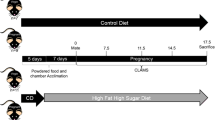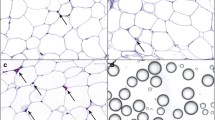Abstract
Adiponectin is believed to be a key factor in determining insulin sensitivity. In turn, insulin sensitivity is known to change from an enhanced state in early pregnancy to a reduced one in late pregnancy. A role for adiponectin in these changes has been proposed for mice but questioned for humans. We addressed this issue in rats by measuring adiponectin expression in both visceral and subcutaneous white adipose tissue, together with tissue content and release of the hormone in non-pregnant and in pregnant rats by days 8, 15 and 19 of pregnancy. Plasma concentration was also determined. No differences were found in any of the parameters measured between non-pregnant and pregnant rats at any time of pregnancy despite changes in white adipose tissue mass and insulin sensitivity. Adiponectin was also detected in cerebrospinal fluid at a concentration 1,000 times lower than in plasma, but again no differences were found between non-pregnant and pregnant animals. It is concluded that adiponectin does not play any role in regulating changes in insulin sensitivity during pregnancy in rats.
Similar content being viewed by others

References
Frühbeck G, Gomez-Ambrosi J, Muruzábal FJ, Burrell AM. The adipocyte: a model for integration of endocrine and metabolic signaling in energy metabolism regulation. Am J Physiol 2001, 280: E827–47.
Trayhurn P, Beattie JH. Physiological role of adipose tissue: white adipose tissue as an endocrine and secretory organ. Proc Nutr Soc 2001, 60: 329–39.
Guerre-Millo M. Adipose tissue and adipokines: for better or worse. Diabetes Metab 2004, 30: 13–9.
Scherer PE, Williams S, Fogliano M, Baldini G, Lodish HF. A novel serum protein similar to C1 q, produced exclusively in adipocytes. J Biol Chem 1995, 270: 26746–9.
Arita Y, Kihara S, Ouchi N, et al. Paradoxical decrease of an adipose-specific protein, adiponectin, in obesity. Biochem Biophys Res Commun 1999, 257: 79–83.
Maeda K, Okubo K, Shimomura I, Funahashi T, Matsuzawa Y, Matsubara K. cDNA cloning and expression of a novel adipose specific collagen-like factor, apM1 (AdiPose Most abundant Gene transcript 1). Biochem Biophys Res Commun 1996, 221: 286–9.
Hu E, Liang P, Spiegelman BM. AdipoQ is a novel adipose-specific gene dysregulated in obesity. J Biol Chem 1996, 271: 10697–703.
Yoda M, Nakano Y, Tobe T, Shioda S, Choi-Miura NH, Tomita M. Characterization of mouse GBP28 and its induction by exposure to cold. Int J Obes Relat Metab Disord 2001, 25: 75–83.
Hotta K, Funahashi T, Arita Y, et al. Plasma concentrations of a novel, adipose-specific protein, adiponectin, in type 2 diabetic patients. Arterioscler Thromb Vasc Biol 2000, 20: 1595–9.
Berg AH, Combs TP, Du X, Brownlee M, Scherer PE. The adipocyte-secreted protein Acrp30 enhances hepatic insulin action. Nat Med 2001, 7: 947–53.
Maeda N, Takahashi M, Funahashi T, et al. PPARgamma ligands increase expression and plasma concentration of adiponectin, an adipose-derived protein. Diabetes 2001, 50: 2094–9.
Yamauchi T, Hara K, Kubota N, et al. Dual roles of adiponectin/Acrp30 in vivo as an anti-diabetic and antiatherogenic adipokine. Curr Drug Targets Immune Endocr Metabol Disord 2003, 3: 243–54.
Yamauchi T, Kamon J, Waki H, et al. The fat-derived hormone adiponectin reverses insulin resistance associated with both lipoatrophy and obesity. Nat Med 2001, 7: 941–6.
Kubota N, Terauchi Y, Yamauchi T, et al. Disruption of adiponectin causes insulin resistance and neointimal formation. J Biol Chem 2002, 277: 25863–6.
Maeda N, Shimomura I, Kishida K, et al. Diet-induced insulin resistance in mice lacking adiponectin/ACRP30. Nat Med 2002, 8: 731–7.
Hotta K, Funahashi T, Bodkin NL, et al. Circulating concentrations of the adipocyte protein adiponectin are decreased in parallel with reduced insulin sensitivity during progression to type 2 diabetes in Rhesus monkeys. Diabetes 2001, 50: 1126–33.
Spranger J, Kroke A, Mohlig M, et al. Adiponectin and protection against type 2 diabetes mellitus. Lancet 2003, 361: 226–8.
Herrera E, Lasunción MA, Huerta L, Martin-Hidalgo A. Plasma leptin levels in rat mother and offspring during pregnancy and lactation. Biol Neonate 2000, 78: 315–20.
Abelenda M, Puerta M. Inhibition of diet-induced thermogenesis during pregnancy in the rat. Pflügers Arch 1987, 409: 314–7.
Herrera E, Lasunción MA, Palacín M, Zorzano A, Bonet B. Intermediary metabolism in pregnancy. First theme of the Freinkel era. Diabetes 1991, 40: 83–8.
González C, Fernández Diaz BB, Fernández S, Patterson AM. Pregnancy in rats and food restriction (50%): insulin response in relation to serum lipids and lipoprotein levels. Nutr Res 1998, 18: 1235–44.
Leturque A, Ferré P, Burnol AF, Kande J, Maulard P, Girard J. Glucose utilization rates and insulin sensitivity in vivo in tissues of virgin and pregnant rats. Diabetes 1986, 35: 172–7.
Leturque A, Hauguel S, Ferré P, Girard J. Glucose metabolism in pregnancy. Biol Neonate 1987, 51: 64–9.
Okuno S, Maeda Y, Yamaguchi Y, et al. Expression of GLUT4 glucose transporter mRNA and protein in skeletal muscle and adipose tissue from rats in late pregnancy. Biochem Biophys Res Commun 1993, 191: 405–12.
Yanase S, Sugiyama T, Sugaya A, Shen XX, Minoura H, Toyoda N. Hexokinase II activity and messenger ribonucleic acid abundance in adipose tissue and skeletal muscle during pregnancy and lactation in rats. Am J Obstet Gynecol 1997, 176: 651–5.
Combs TP, Berg AH, Rajala MW, et al. Sexual differentiation, pregnancy, calorie restriction, and aging affect the adipocyte-specific secretory protein adiponectin. Diabetes 2003, 52: 268–76.
Kondo E, Sugiyama T, Kusaka H, Toyoda N. Adiponectin mRNA levels in parametrial adipose tissue and serum adiponectin levels are reduced in mice during late pregnancy. Horm Metab Res 2004, 36: 465–9.
Ramsay JE, Jamieson N, Greer IA, Sattar N. Paradoxical elevation in adiponectin concentrations in women with preeclampsia. Hypertension 2003, 42: 891–4.
Chomczynski P, Sacchi N. Single-step method of RNA isolation by acid guanidinium thiocyanate-phenol-chloroform extraction. Anal Biochem 1987, 162: 156–9.
Trayhurn P, Duncan JS, Nestor A, Thomas MEA, Rayner DV Chemiluminescent detection of mRNAs on northern blots with digoxigenin end-labelled oligonucleotides. Anal Biochem 1994, 222: 224–30.
Puerta M, Abelenda M, Rocha M, Trayhurn P. Effect of acute cold exposure on the expression of the adiponectin, resistin and leptin genes in rat white and brown adipose tissues. Horm Metab Res 2002, 34: 629–34.
Trayhurn P, Duncan JS, Rayner DV. Acute cold-induced suppression of ob (obese) gene expression in white adipose tissue of mice: mediation by the sympathetic system. Biochem J 1995, 311: 729–33.
Lundbaek K. Intravenous glucose tolerance as a tool in definition and diagnosis of diabetes mellitus. Br Med J 1962, 5291: 1507–13.
Bonora E, Moghetti P, Zancanaro C, et al. Estimates of in vivo insulin action in man: comparison of insulin tolerance tests with euglycemic and hyperglycemic glucose clamp studies. J Clin Endocrinol Metab 1989, 68: 374–8.
Altomonte J, Harbaran S, Richter A, Dong H. Fat depot-specific expression of adiponectin is impaired in Zucker fatty rats. Metabolism 2003, 52: 958–63.
Worda C, Leipold H, Gruber C, Kautzky-Willer A, Knofler M, Bancher-Todesca D. Decreased plasma adiponectin concentrations in women with gestational diabetes mellitus. Am J Obstet Gynecol 2004, 191: 2120–4.
Thyfault JP, Hedberg EM, Anchan RM, et al. Gestational diabetes is associated with depressed adiponectin levels. J Soc Gynecol Investig 2005, 12: 41–5.
Grueso E, Rocha M, Puerta M. Plasma and cerebrospinal fluid leptin levels are maintained despite enhanced food intake in progesterone-treated rats. Eur J Endocrinol 2001, 144: 659–65.
Rocha M, Grueso E, Puerta M. The anorectic effect of oestradiol does not involve changes in plasma and cerebrospinal fluid leptin concentrations in the rat. J Endocrinol 2001, 171: 349–54.
Haque MS, Minokoshi Y, Hamai M, Iwai M, Horiuchi M, Shimazu T. Role of sympathetic nervous system and insulin in enhancing glucose uptake in peripheral tissues after intrahypothalamic injection of leptin in rats. Diabetes 1999, 48: 1706–12.
Bruning JC, Gautam D, Burks DJ, et al. Role of brain insulin receptors in the control of body weight and reproduction. Science 2000, 289: 2122–5.
Obici S, Feng Z, Karkanias G, Baskin DG, Rosetti L. Decreasing hypothalamic insulin receptors causes hyperphagia and insulin resistance in rats. Nat Neurosci 2002, 5: 566–72.
Banerjee RR, Rangwala SM, Shapiro JS, et al. Regulation of fasted blood glucose by resistin. Science 2004, 303: 1195–8.
Caja S, Martinez I, Abelenda M, Puerta M. Resistin expression and plasma concentration peak at different times during pregnancy in rats. J Endocrinol 2005, 185: 551–9.
Author information
Authors and Affiliations
Corresponding author
Rights and permissions
About this article
Cite this article
Caja, S., Torrente, M., Martínez, I. et al. Adiponectin values are unchanged during pregnancy in rats. J Endocrinol Invest 28, 609–615 (2005). https://doi.org/10.1007/BF03347259
Accepted:
Published:
Issue Date:
DOI: https://doi.org/10.1007/BF03347259



